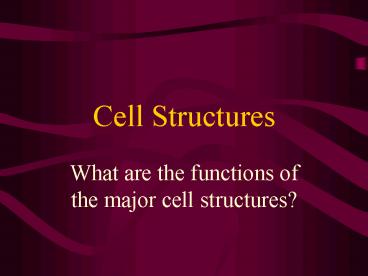Cell Structures - PowerPoint PPT Presentation
1 / 39
Title: Cell Structures
1
Cell Structures
- What are the functions of the major cell
structures?
2
Cell Wall
- Found in plants, algae, fungi and nearly all
prokaryotes - Lie outside the cell membrane
- Made up of fibers of carbohydrate and protein
- Plant cell walls made of cellulose
- MAIN FUNCTION provide support and protection for
the cell
3
Image from http//users.rcn.com/jkimball.ma.ultra
net/BiologyPages/P/PlantCell.html
4
Plant Cell Wall Structure
Image from http//www.tvdsb.on.ca/westmin/science
/sbi3a1/Cells/cellwall.htm
5
Bacterial cell walls
- Made up of peptidoglycan
- Different structures for different types of
bacteria
6
Fungal and Algal cell walls
- Fungal cell walls
- Composed of chitin and cellulose
- Algal Cell Walls
- Composed of polysaccharides
- Which polysaccharides depends on the algae
7
Nucleus
- Controls most of the cell processes and contains
the hereditary information (DNA) - Parts of the nucleus
- Chromatin and chromosomes
- Nucleolus
- Nuclear envelope
8
Image from http//sun.menloschool.org/birchler/c
ells/animals/nucleus/
9
- Image from http//www.daviddarling.info/encyclope
dia/N/nucleusc.html
10
Image from http//cellbio.utmb.edu/cellbio/nucleu
s.htm
11
Chromatin and Chromosomes
- Chromatin
- The granular material visible within the nucleus
- Consists of DNA bound to proteins
- Chromosomes
- Chromatin condenses into chromosomes before cell
division - Contain genetic information
12
Nucleolus
- Assembly of ribosomes begins here
13
Nuclear envelope
- Double membrane layer surrounding the cell
- Has pores which allows material into and out of
the cell
14
Cytoskeleton
- Network of protein filaments that help the cell
maintain its shape - Involved in many forms of cell movement
15
Parts of the Cytoskeleton
- Microtubules
- Hollow tubes of protein that maintain shape
- Serve as tracks for moving organelles
- Important in cell division
- Make up centrioles in animal cells
- Also make up flagella and cilia in some cells
16
Microtubules
Images from http//users.rcn.com/jkimball.ma.ultr
anet/BiologyPages/C/Cytoskeleton.html
17
Parts of the Cytoskeleton
- Microfilaments
- Long, thin fibers that function in the movement
and support of the cell - Much smaller than microtubules
18
Microfilaments
19
Ribosomes
- Small particles of RNA and protein
- Function assemble proteins
- Prokaryotic and Eukaryotic ribosomes have
different structures
20
Ribosomes consist of a small subunit and a large
subunit
Image from http//cellbio.utmb.edu/cellbio/riboso
me.htm
21
Endoplasmic Reticulum
- Function Components of the cell membrane are
assembled and some proteins are modified - Rough ER Synthesis of proteins chemical
modification Studded with ribosomes - Smooth ER synthesis of lipids
22
Image from http//www.winterwren.com/apbio/cellor
ganelles/er.html
23
Image from http//biology.about.com/library/weekl
y/aa041300a.htm
24
Golgi Apparatus
- Function enzymes in the Golgi attach
carbohydrates and lipids to proteins - From Golgi proteins are packaged and sent to
their final destinations
25
Image from http//cellbio.utmb.edu/cellbio/GOLGI.
HTM
26
Image from http//cellbio.utmb.edu/cellbio/GOLGI.
HTM
27
Lysosomes
- Small organelles filled with enzymes
- Function break down lipids, carbohydrates and
proteins from food particles - Break down old organelles and other cellular
debris
28
Image from http//cellbio.utmb.edu/cellbio/lysoso
me.htm
29
Vacuoles
- Function Store materials such as water, salts,
proteins, and carbohydrates - In plants, a large central vacuole filled with
fluid is used for support in the cell
30
Image from http//micro.magnet.fsu.edu/cells/plan
ts/images/plantvacuolesfigure1.jpg
31
Chloroplasts
- Function use energy from the sun to make
energy-rich food molecules in photosynthesis - Bound by two envelope membranes
- Stacks of photosynthetic membranes contain
chlorophyll
32
Image from http//www.daviddarling.info/images/ch
loroplast.jpg
33
Mitochondria
- Function use energy from food to make high
energy compounds - Powerhouse of the cell
- Bound by two envelope membranes
- Inner membrane is folded
34
Image fromhttp//micro.magnet.fsu.edu/cells/mitoc
hondria/images/mitochondriafigure1.jpg
35
Organelle DNA
- Chloroplasts and mitochondria contain their own
DNA - Endosymbiotic theorymitochondria and
chloroplasts the result of endocytosis of
bacteria and blue-green algae whichbecame
symbiotic
36
Endosymbiotic theory
37
Image from http//www.msnucleus.org/membership/ht
ml/k-6/lc/organ/5/images/wpeA.gif
38
Venn Diagram
- Use your notes and the venn diagram handout to
compare and contrast prokaryotic and eukaryotic
cells and plant and animal cells
39
Cell as a Factory
- See page 182































